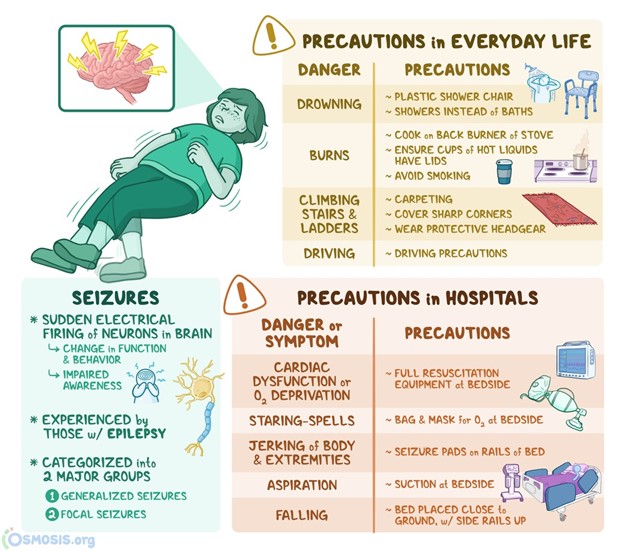A nurse is caring for an adolescent who has hyperthermia.
Which of the following actions should the nurse take?
Cover the adolescent with a thermal blanket
Submerge the adolescent’s feet in ice water
Initiate seizure precautions
Administer oral acetaminophen
The Correct Answer is C

Hyperthermia is a condition in which the body temperature is abnormally high, usually due to exposure to heat, infection, or certain medications.
Hyperthermia can cause neurological complications, such as seizures, confusion, or coma. Therefore, the nurse should initiate seizure precautions for an adolescent who has hyperthermia to prevent injury and protect the airway.
Choice A is wrong because covering the adolescent with a thermal blanket would increase the body temperature and worsen hyperthermia. The nurse should remove excess clothing and use cooling measures, such as fans, ice packs, or cool fluids.
Choice B is wrong because submerging the adolescent’s feet in ice water would cause vasoconstriction and shivering, which would reduce heat loss and increase heat production. The nurse should avoid using extreme cold or ice water to cool the body.
Choice D is wrong because administering oral acetaminophen would not be effective for hyperthermia caused by non-infectious factors, such as heat exposure or medications.
Acetaminophen lowers the body temperature by reducing the hypothalamic set point, which is not altered in hyperthermia. Additionally, oral medications may be difficult to swallow or absorb in a hyperthermic patient.
Normal body temperature ranges from 36.5°C to 37.5°C (97.7°F to 99.5°F). Hyperthermia is defined as a body temperature above 38.5°C (101.3°F).
Nursing Test Bank
Naxlex Comprehensive Predictor Exams
Related Questions
Correct Answer is D
Explanation
Choice A reason:
Determine previous coping skills used by the client is not appropriate. Assessing the client's previous coping skills is an essential step in the assessment phase of the therapeutic relationship, not specifically during the orientation phase. This information helps the nurse to understand the client's coping mechanisms and identify potential areas for improvement or support.
Choice B reason:
Facilitate the client's problem-solving skills is not appropriate the nurse may work on facilitating the client's problem-solving skills throughout the therapeutic relationship, including during the working phase. During this phase, the nurse and client collaborate to explore and address the client's concerns and challenges.
Choice Creason:
Assisting the client in expressing alternative behaviours is not appropriate. This action may also be part of the working phase, where the nurse helps the client explore alternative behaviours and coping strategies to address their issues and challenges.
Choice D reason:
The orientation phase is the initial stage of the therapeutic relationship where the nurse and the client get to know each other and establish the groundwork for their working relationship. During this phase, it is essential to clarify the roles and responsibilities of both the nurse and the client to ensure a clear understanding of each other's expectations.
Correct Answer is B
Explanation

The systolic pressure is estimated by noting the pressure at which the pulse disappears and reappears. The diastolic pressure is not measured by this method, but it can be useful when the sounds are difficult to hear.
Choice A is wrong because applying the largest cuff available can result in a falsely low reading. The cuff size should be appropriate for the client’s arm circumference.
Choice C is wrong because placing the arm above the level of the client’s heart can also cause a falsely low reading. The arm should be at the level of the heart for an accurate measurement.
Choice D is wrong because deflating the cuff quickly can lead to missing or skipping sounds, resulting in an inaccurate reading. The cuff should be deflated slowly and evenly.
Normal ranges for blood pressure vary depending on age, sex, and health conditions, but generally, a systolic pressure below 120 mmHg and a diastolic pressure below 80 mmHg are considered normal for adults.
Whether you are a student looking to ace your exams or a practicing nurse seeking to enhance your expertise , our nursing education contents will empower you with the confidence and competence to make a difference in the lives of patients and become a respected leader in the healthcare field.
Visit Naxlex, invest in your future and unlock endless possibilities with our unparalleled nursing education contents today
Report Wrong Answer on the Current Question
Do you disagree with the answer? If yes, what is your expected answer? Explain.
Kindly be descriptive with the issue you are facing.
